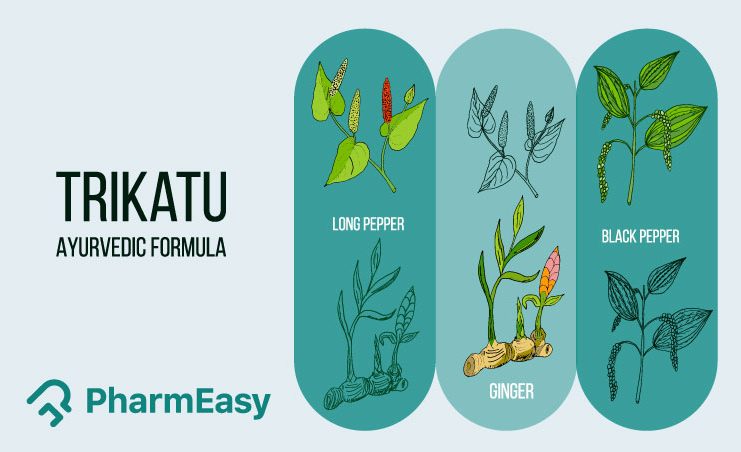Trikatu Churna: Uses, Benefits and Side Effects by Dr. Rajeev Singh
By Dr Rajeev Singh +2 more

Get,

to manage your symptom
Get your,


4 Cr+ families
benefitted

OTP sent to 9988776655



You’ve successfully subscribed to receive
doctor-approved tips on
Whatsapp

Get ready to feel your best.

Hi There,
Download the PharmEasy App now!!


Register to Avail the Offer
Send OTPBy continuing, you agree with our Privacy Policy and Terms and Conditions

Hi There,
Sign up on PharmEasy now!!
Trusted by 4 crore+ families

OTP sent to 9988776655



You have unlocked 25% off on medicines




Code: NU25
By Dr Rajeev Singh +2 more
Table of Contents
Originating in the Vedic period, Ayurveda is an ancient Indian medicine system that relies on the principle that “life is an interplay of five elements-water, air, fire, space and earth.” Owing to Ayurveda, the knowledge of nature has been passed down from generation to generation. There are numerous ways to incorporate the science of Ayurveda into your life for healing; one such way is by using churnas, a mixture of herbs and natural ingredients. Trikatu churna is an age-old remedy used for some excellent health benefits. It is a mixture/powder (churna) of three (tri) most essential herbs (katu), namely adrak (ginger or Zingiber officinale), kali mirch (Black pepper or piper nigrum) and pippali (long pepper or Piper longum). In this article, we will learn more about Trikatu churna, its health benefits, side effects, precautions, etc1.

Did you know?
As already mentioned, Trikatu churna is a combination of Zingiber officinale, piper nigrum and piper longum3. All three herbs are rich in different nutrients and phytochemicals with medicinal value. The nutritional chart of Trikatu churna is given below:
Trikatu churna is rich in phytochemicals having a high medicinal value. The phytochemicals present in Trikatu churna include phytosterol, beta-sitosterol, acetic acid, amides, piperlongumine, genistein, E-beta carotene, etc2,5.
Trikatu churna shows numerous scientifically proven properties; some of which are mentioned below5:
Some of the potential benefits of Trikatu churna are described below.

Type II Diabetes is characterized by increased blood glucose due to reduced production or resistance to insulin (a hormone that regulates blood glucose). Ayurvedic formulations like churnas have been gaining the limelight for managing diabetes. Chabbra et al. conducted a study4 in 2022 that showed the presence of phytochemicals like genistein, piperlongumine, beta-sitosterol, beta-carotene, etc., in Trikatu churna. These phytochemicals regulate insulin resistance pathways and may help reduce blood glucose. Additionally, genistein may help improve insulin synthesis. This indicates that Trikatu churna may help manage Type II diabetes. However, to claim these results in humans, we need more studies. It is further advised not to self-medicate and consult your physician for proper management of diabetes5.

The liver is a large organ on the abdomen’s right side. It is mainly responsible for filtering waste from the body, including bilirubin, producing bile which helps to digest food and storing sugar in the body, which can later be used as an energy source. Different liver enzymes perform all these functions; any liver disease will be characterized by an abnormal value of these liver enzymes. Sharma et al. conducted a review1 that stated that Trikatu churna might exert a protective effect on the liver by improving liver enzymes and function. This may indicate that the Trikatu churna may protect the liver and help in conditions like alcoholic liver disease. However, more studies on humans are needed to support these claims. Additionally, it is advised not to rely on this churna as a remedy, and kindly consult your physician for the proper management of any liver disease1.

A lipid profile is a complete cholesterol test that measures total cholesterol, triglycerides, low-density lipoprotein (LDL), high-density lipoprotein (HDL), etc. Valsala et al., 2013 conducted an animal study5 to assess the effect of Trikatu churna on lipid profile. The consumption of this churna showed a declining trend in total cholesterol and triglycerides and helped increase high-density lipoprotein or good cholesterol levels. Thus, Trikatu churna may positively impact the lipid profile. However, we need more human studies to claim these results accurately. Also, it is advised not to consider this churna as an alternative to modern medicine; you should always consult your doctor for proper management of an abnormal lipid profile6.

Rheumatoid arthritis is a long-term inflammatory disease affecting the joints. It is manifested by inflammation and pain in the joints. Literature studies show that Trikatu churna may manage inflammatory conditions like rheumatoid arthritis. Vachana et al. conducted a study10 in 2014 which stated that Trikatu churna might help reduce inflammation due to the presence of phytochemicals like gingerol, piperine, etc. This indicates that Trikatu churna may potentially benefit rheumatoid arthritis and provide symptomatic relief. However, we need more studies to confirm these results with greater reliability. Additionally, you should not consider this churna as a remedy for managing rheumatoid arthritis; it is always advised to consult a physician for proper management7.

Digestive disorders are increasing globally and affecting people of all age groups. Christine et al. conducted a review6 in 2019 that stated that Trikatu churna might help improve digestion and gut flora and have a prebiotic effect. Additionally, it may have an anti-carminative effect (reduce flatulence) due to phytoconstituents like beta carotene, acetic acid, piperine, etc. Therefore, Trikatu churna may have the potential to manage digestive disorders and improve gut health. To claim these results in humans, we need more studies. It is further advised not to consider this churna as an alternative to modern medicine; kindly consider your doctor for proper management of any digestive disorder8.

Though there are studies that show the benefits of Trikatu churna in various conditions, these are insufficient and there is a need for further studies to establish the true extent of the benefits of Trikatu churna on human health.
Trikatu churna is believed to possess anti-inflammatory, anti-dyslipidaemic, and immune-modulatory characteristics and it might suppress certain pro-inflammatory cytokines. Based on some studies, Trikatu churna might be beneficial for managing COVID-19 cases11.
Dr. Siddharth Gupta, B.A.M.S, M.D (Ayu)
You must consult a qualified doctor before taking any herbal supplements. Do not discontinue or replace an ongoing treatment of modern medicine with an ayurvedic/herbal preparation without consulting a qualified doctor.
Chanda et al. conducted an animal study7 that found Trikatu churna to be safe; however, there are no studies conducted on humans to assess the side effects of Trikatu churna. You should avoid excessive consumption of this churna as it may cause your blood glucose and lipid levels to drop too low.
However, if you experience any adverse reactions to Trikatu churna, it is advised to discontinue its intake and immediately contact a doctor or your Ayurvedic physician who has prescribed it. They will be able to guide you appropriately for your symptoms5,6,8.
Trikatu churna might be beneficial for managing various health issues like colds, coughs, nasal congestion, etc. Due to the presence of various phytochemicals, it might possess anti-microbial, anti-fungal, and analgesic properties and might be useful as a go-to remedy in common health conditions12.
Dr. Rajeev Singh, BAMS
Consuming Trikatu churna is okay if taken in moderate amounts. However, caution is warranted if you belong to special groups, as under:
However, you must always seek the advice of your Ayurvedic physician about the possible interaction of Trikatu churna with other drugs and follow the prescription thoroughly, as they will know your health condition and other medications you are taking.
Trikatu churna is an age-old remedy used for some excellent health benefits. It is a mixture/powder (churna) of three (tri) most essential herbs (katu), namely adrak (ginger or Zingiber officinale), kali mirch (Black pepper or piper nigrum) and pippali (long pepper or Piper longum)1.
Yes, Trikatu churna may help in weight loss and, thus, help manage obesity1.
Yes, Trikatu churna may help in the treatment of cough.
No, there are no proven results for the effects of Trikatu churna on hair loss.
The safety of Trikatu churna consumption in pregnancy is not well-established; it is therefore advised to avoid its use and consult your doctor for the same.
Disclaimer: The information provided here is for educational/awareness purposes only and is not intended to be a substitute for medical treatment by a healthcare professional and should not be relied upon to diagnose or treat any medical condition. The reader should consult a registered medical practitioner to determine the appropriateness of the information and before consuming any medication. PharmEasy does not provide any guarantee or warranty (express or implied) regarding the accuracy, adequacy, completeness, legality, reliability or usefulness of the information; and disclaims any liability arising thereof.
Links and product recommendations in the information provided here are advertisements of third-party products available on the website. PharmEasy does not make any representation on the accuracy or suitability of such products/services. Advertisements do not influence the editorial decisions or content. The information in this blog is subject to change without notice. The authors and administrators reserve the right to modify, add, or remove content without notification. It is your responsibility to review this disclaimer regularly for any changes.
Comments

Leave your comment...
You may also like
Comments